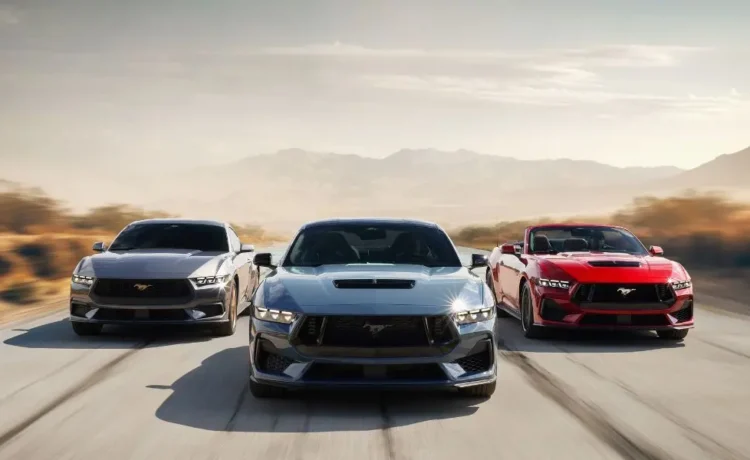Some cars make a splash and vanish. Others show up, hang around for a while, and quietly fade into memory.
But the Ford Mustang? It didn’t just appear — it announced itself.
This wasn’t some corporate project polished in a boardroom. It was lightning caught in steel and rubber — the kind of accident that only happens once in an era. The Mustang hit the streets when America was restless, chasing new music, new ideas, and new roads. It looked fast even when it was parked, and it made freedom feel like something you could actually buy.
1964: When Everything Shifted
The debut could’ve been ordinary — another shiny car rolled out for a world’s fair crowd. But when Ford unveiled the Mustang at the New York World’s Fair in 1964, it was like someone flipped a switch.
People lined up outside dealerships the same week. Within 18 months, Ford had sold more than a million. That’s not marketing hype — that’s proof the Mustang struck a nerve.
What made it work was simple: it had style without snobbery, muscle without madness, and a price tag people could reach. You didn’t need a mansion or a film deal to drive one. Just a job, a dream, and a weekend plan.
The Soul of the 60s
The 1960s were alive — loud music, rebellion, risk-taking. The Mustang slid right into that chaos like it was born for it.
It wasn’t about getting from point A to B anymore. It was about the in-between. The sound of the engine, the wind pushing back, that small thrill every time the light turned green.
Owning a Mustang wasn’t about status; it was about identity. It said, “I’m not here to follow.”
And somehow, it made everyone — from college kids to executives — feel that same spark.
Hollywood Turned It Into a Legend
Then came 1968 — Bullitt.
Steve McQueen, a green Fastback, and one of the greatest car chases ever filmed. The Mustang didn’t just appear in the movie; it stole the movie.
That roar echoing off the streets of San Francisco turned a cool car into an icon. It wasn’t just something you could drive — it became something you could feel.
And ever since, it’s shown up everywhere: in music videos, games, blockbusters. Each new appearance pulls another generation into the story.
Built for Everyone, Not Just Gearheads
What made the Mustang unstoppable was that it didn’t lock anyone out.
You could buy one that was calm and cruisy, or one that could snarl down a straight line. Convertible, coupe, Fastback — it gave people options. Teenagers, families, collectors — everyone found a reason to say yes.
It was powerful, sure, but it was also friendly. You didn’t need to be a racer to love it. You just had to love driving.
The Low Points (and Why It Survived Anyway)
Every icon has rough patches. The 1970s oil crisis nearly killed the muscle car dream. Gas was expensive, power was frowned upon, and suddenly everyone wanted smaller engines.
The Mustang II? Let’s be honest — not its proudest moment. But it kept the name alive. That matters.
And when the 80s rolled around and America rediscovered speed and excess, the Mustang came back loud and unapologetic. It had stumbled but never disappeared — a comeback story that mirrored its fans.
Evolving, but Never Losing Its Soul
The Mustang has changed a hundred times over. It’s sharper now, sleeker, smarter. It’s gone from pure muscle to modern performance without losing the spark that made people fall in love with it in the first place.
That’s the secret — it adapts without pretending to be something it’s not. Even the electric models carry that same spirit: independent, confident, alive.
You see one in the mirror, and you know what it is. No badge needed.
The Mustang in Miami
Fast forward to now, and the Mustang still fits right into Miami’s rhythm.
There’s something about that mix of ocean air, neon nights, and open roads that feels made for it. You’ll catch them cruising Ocean Drive or growling through Brickell like they own the street.
And thanks to services like exotic car rental Miami, anyone can live the legend — even just for a day. The Mustang’s not just about owning; it’s about experiencing.
If you’re in Coral Gables, Exotic Car Rental in Coral Gables offers the perfect backdrop — shaded streets, Mediterranean architecture, and that Florida sunlight bouncing off the hood. It’s like time travel, only louder.
Why It Still Matters
So why does the Mustang still make people turn their heads after sixty years?
Because it connects, it still feels human — flawed, bold, alive. It’s not a car that whispers. It’s a car that talks back.
Every rev says something different: freedom, nostalgia, power, hope. Whatever it means to you, it means something.
And that’s the difference between a car and an icon.
FAQs
What exactly makes the Mustang a “pony car”?
It started the whole idea — a small, sporty, affordable car with a big personality. Others followed, but the Mustang defined it.
Which Mustang became famous in Hollywood?
The 1968 Fastback from Bullitt — that chase scene rewrote movie history.
Did the Mustang ever lose its spark?
For a moment, yes. But it always came back swinging. The legend never flatlined.
Can I rent a Mustang in Miami?
Absolutely. Premier Auto Miami offers top models so you can live the story — even if it’s just for a weekend drive down the coast.
The Takeaway
The Ford Mustang wasn’t designed to last forever. It just refused to.
It’s changed with every decade, survived every storm, and still manages to make people fall in love with driving again.
It’s not perfect — and maybe that’s why it’s perfect.
Because like all legends, it’s not just about the past. It’s about how it still makes you feel right now.

